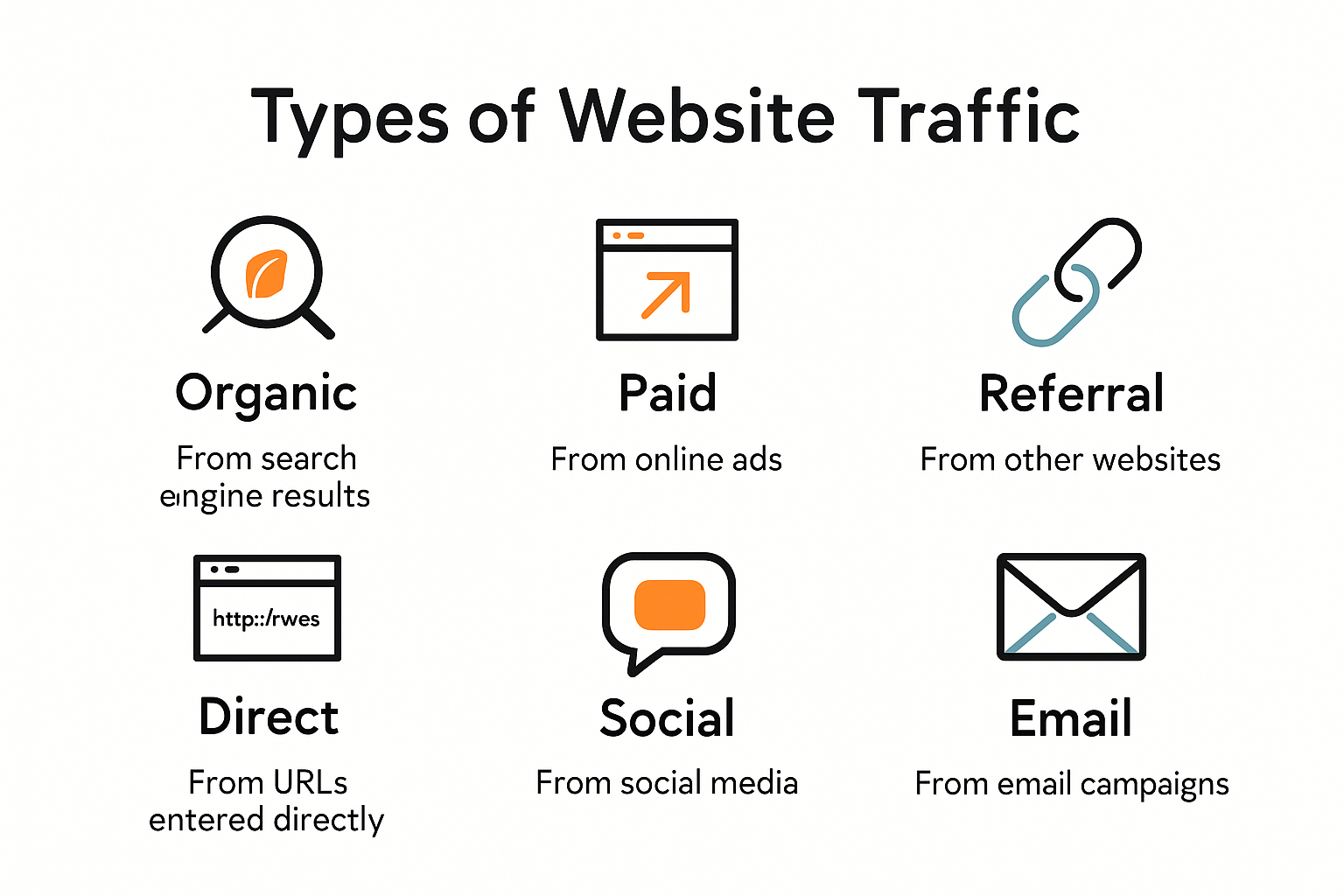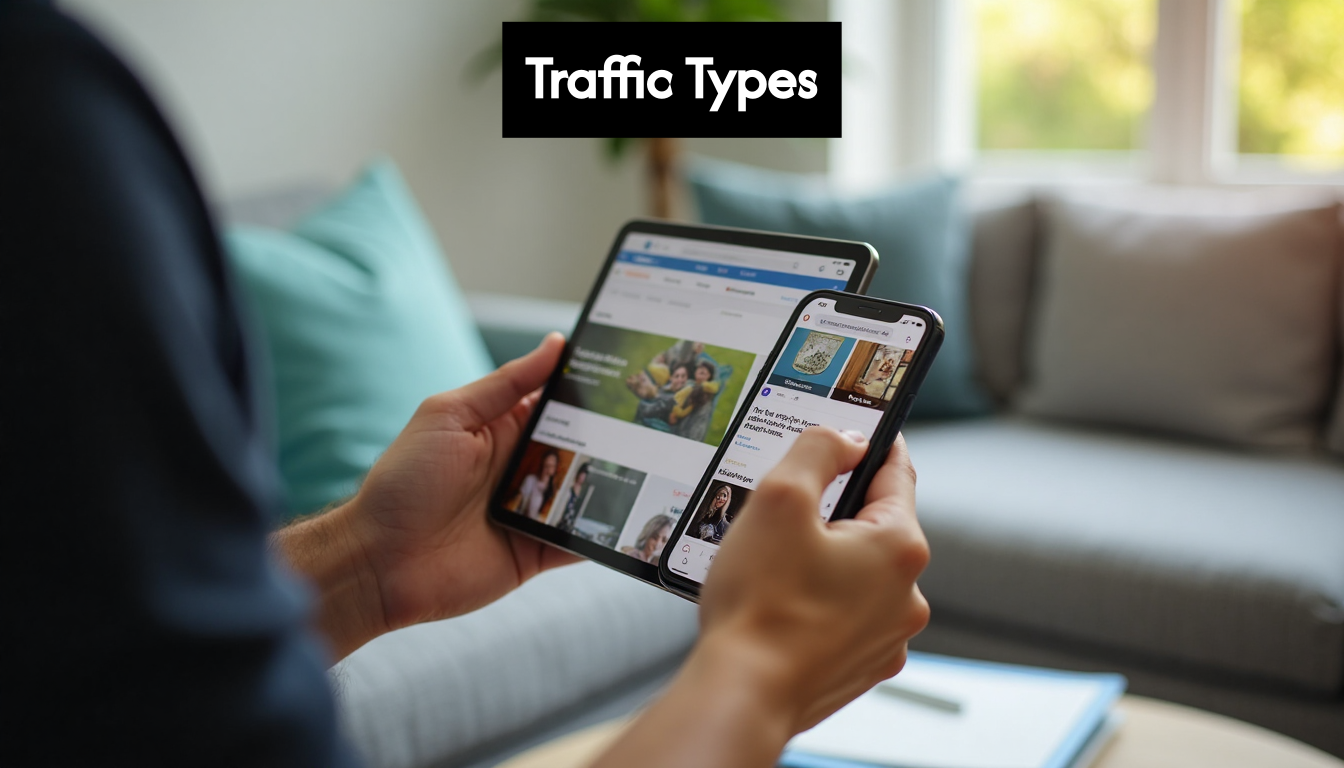Types of Website Traffic Explained: Essential Guide for 2025


Website traffic sounds straightforward, but it’s actually a web of sources that shape every digital strategy. Mobile devices now make up an impressive 41 percent of all website visits, signaling a huge shift in how users find and interact with content online. Most people focus on chasing high numbers, expecting quantity to win the day. The reality is that understanding where your traffic comes from and tailoring your approach to each source can flip average results into breakthrough performance.
Table of Contents
- Understanding The Major Types Of Website Traffic
- How Different Traffic Types Affect Your Goals
- Best Practices To Optimize Each Traffic Source
- Tracking And Analyzing Website Traffic Effectively
Quick Summary
| Takeaway | Explanation |
|---|---|
| Understanding Traffic Types | Recognizing the different types of website traffic—organic, paid, referral, direct, social, and email—enables businesses to tailor their marketing strategies effectively. |
| Optimizing for Device Diversity | With mobile devices accounting for 41% of traffic, creating responsive designs is critical for enhancing user experience and conversion rates. |
| Quality Over Quantity | Focusing on the quality and intent of traffic sources, rather than just volume, leads to higher engagement and better conversion potential. |
| Leveraging Best Practices | Implementing source-specific optimization strategies, such as effective keyword placement and clear call-to-actions, enhances overall digital performance. |
| Advanced Traffic Analysis | Utilizing advanced tracking techniques, such as audience segmentation and predictive modeling, allows businesses to gain actionable insights and improve their marketing efforts. |
Understanding the Major Types of Website Traffic
Website traffic is the lifeblood of digital success. Understanding the various types of traffic enables businesses to develop targeted strategies that maximize online visibility and user engagement. In 2025, businesses need a comprehensive approach to traffic acquisition that goes beyond traditional metrics.
The Traffic Ecosystem: Core Sources and Strategies
Website traffic is not a monolithic concept but a complex ecosystem of different sources. Research from SEO experts reveals six primary types of website traffic that digital professionals must understand:
- Organic Traffic: Visitors arriving through search engine results without paid advertising
- Paid Traffic: Users clicking on sponsored search or display advertisements
- Referral Traffic: Visitors coming from links on other websites
- Direct Traffic: Users typing your website URL directly or using bookmarks
- Social Traffic: Visitors arriving from social media platforms
- Email Traffic: Users clicking links within email marketing campaigns

Device-Driven Traffic Dynamics
Device diversity significantly impacts traffic patterns. Recent mobile traffic statistics demonstrate the evolving digital landscape. In 2025, mobile devices account for 41% of website traffic, desktops represent 38%, and tablets contribute 19%. This fragmentation underscores the critical need for responsive, multi-device website design.
Understanding these traffic sources allows businesses to:
- Optimize Marketing Strategies: Allocate resources effectively across different channels
- Improve User Experience: Tailor content and design for specific traffic sources
- Enhance Conversion Rates: Create targeted approaches for each traffic type
Strategic Traffic Analysis
Comprehensive research from industry experts indicates that successful digital strategies require nuanced traffic analysis. While each traffic type offers unique advantages, inbound and referral sources frequently provide the highest quality visitor engagement.Businesses must move beyond simple traffic volume metrics and focus on:
- Source quality and relevance
- Visitor intent and behavior
- Conversion potential of different traffic channels
By developing a holistic understanding of website traffic types, organizations can create more intelligent, data-driven digital marketing approaches that adapt to the complex online ecosystem of 2025.
How Different Traffic Types Affect Your Goals

Every website traffic type carries unique strategic implications for business objectives. Understanding how different traffic sources align with specific goals enables more precise digital marketing approaches and resource allocation.
Traffic Conversion and Performance Metrics
Research from digital marketing experts reveals fascinating insights into traffic performance across channels:- Social Media Traffic: Generates 16% of website visitors, highlighting its potential for brand awareness and engagement
- Email Marketing Traffic: Delivers 14% of website visitors with exceptional targeting capabilities
- Paid Search Traffic: Accounts for 9% of total website traffic, offering immediate visibility
These percentages demonstrate that each traffic source contributes differently to overall business goals. Smart marketers recognize that raw traffic volume matters less than the quality and intent behind those visitors.
Strategic Goal Alignment
Different traffic types support distinct organizational objectives:
- Organic Traffic: Best for long-term credibility and sustainable growth
- Paid Traffic: Ideal for rapid market testing and immediate campaign results
- Referral Traffic: Excellent for building industry authority and networking
- Social Traffic: Perfect for brand awareness and community engagement
Conversion Rate Optimization
Traffic quality trumps quantity in modern digital marketing. Marketing research indicates that targeted traffic with high purchase intent delivers superior conversion rates compared to broad, untargeted visitor streams.
Businesses should focus on:
- Understanding visitor intent for each traffic source
- Creating tailored landing pages
- Developing channel-specific engagement strategies
- Measuring granular performance metrics
By recognizing how different traffic types uniquely contribute to business objectives, organizations can design more nuanced, effective digital marketing strategies that transform website visitors into valuable customers.
Best Practices to Optimize Each Traffic Source
Successful digital marketing requires targeted optimization strategies for each website traffic source. By implementing source-specific best practices, businesses can significantly enhance user engagement, conversion rates, and overall digital performance.
Organic Traffic Optimization Strategies
SEO experts at Backlinko recommend foundational practices to maximize organic search traffic:- Keyword Placement: Use primary keywords early in content
- Content Quality: Create unique, authoritative titles and descriptions
- Technical SEO: Build high-quality backlinks
- Performance Optimization: Improve website loading speed
These strategies help websites rank higher in search results and attract more qualified organic visitors. Research indicates that websites with faster load times and superior user experience retain visitors more effectively.
Paid and Referral Traffic Conversion Techniques
Conversion optimization experts emphasize critical techniques for paid and referral traffic:- Landing Page Design: Create clear, focused messaging
- Call-to-Action Optimization: Develop prominent, compelling CTAs
- A/B Testing: Continuously test page elements
- Targeting Refinement: Adjust audience targeting based on performance data
Successful paid traffic strategies require constant refinement and data-driven decision making. Understanding audience intent and creating highly relevant landing experiences dramatically improves conversion potential.
Cross-Channel User Experience Enhancement
Modern digital marketing demands a holistic approach to traffic optimization. User experience researchers recommend universal strategies that work across all traffic sources:
- Ensure responsive mobile design
- Minimize page load times
- Create intuitive navigation
- Develop consistent brand messaging
- Implement clear value propositions
By treating website optimization as a comprehensive discipline rather than channel-specific tactics, businesses can create more engaging digital experiences that convert visitors across all traffic sources.
The key to successful traffic optimization lies in continuous learning, testing, and adapting. No single strategy works forever, making ongoing analysis and refinement essential for digital marketing success in 2025.
Tracking and Analyzing Website Traffic Effectively
In the digital marketing landscape of 2025, understanding website traffic goes far beyond counting visitors. Effective tracking and analysis provide critical insights that drive strategic decision making and optimize online performance.
Essential Traffic Analysis Tools and Metrics
Digital analytics experts recommend comprehensive tracking approaches that capture nuanced visitor behavior. Modern traffic analysis involves monitoring:- Real-time visitor statistics
- Traffic source breakdown
- User demographic information
- Engagement duration and patterns
- Conversion pathway tracking
Advanced Tracking Techniques
Effective traffic analysis in 2025 requires a multi-dimensional approach. Performance optimization specialists highlight several advanced tracking techniques:
- Competitive benchmarking
- Audience segmentation
- Historical performance comparison
- Predictive behavior modeling
- Cross-channel attribution analysis
These techniques transform raw data into actionable strategic insights. By understanding how different visitor segments interact with your website, businesses can create more targeted, personalized experiences.
Transforming Data into Strategic Insights
Successful traffic analysis is not about collecting data but interpreting it meaningfully. Key strategies include:
- Identifying high-performing content
- Understanding user navigation patterns
- Recognizing potential conversion barriers
- Detecting emerging audience segments
- Evaluating marketing channel effectiveness
Businesses that master traffic analysis can make precise, data-driven decisions that significantly improve online performance. The goal is not just to track traffic but to understand the story behind the numbers.
In 2025, website traffic analysis is a sophisticated discipline requiring continuous learning, advanced tools, and a strategic mindset. Organizations that develop robust tracking capabilities will gain a significant competitive advantage in the digital marketplace.
Frequently Asked Questions
What are the main types of website traffic?
Website traffic primarily consists of six types: organic, paid, referral, direct, social, and email traffic. Each type plays a unique role in digital marketing strategies.
How does mobile traffic impact website design?
Mobile devices account for 41% of website traffic, making responsive design essential. Optimizing mobile experiences can significantly enhance user engagement and conversion rates.
Why is traffic quality more important than quantity?
Focusing on traffic quality allows businesses to attract visitors with high intent, leading to better engagement and conversion rates instead of just high visitor numbers.
What are effective strategies to optimize organic traffic?
To optimize organic traffic, implement strategies such as effective keyword placement, high-quality content creation, and technical SEO practices to improve search engine rankings.
Ready to Turn Every Website Visit Into a Business Win?
Struggling to turn your website traffic into real, measurable growth? The article highlighted how important it is to focus on quality traffic sources, advanced tracking, and clear conversion strategies. But keeping up with SEO trends and content planning feels overwhelming, especially when the online world keeps evolving so quickly. What if you could skip the guesswork and let a smart platform handle your SEO challenges for you?

Let BabyLoveGrowth.ai help you stand out. Our AI-powered system analyzes your business, builds a full 30-day content plan, and automatically delivers optimized articles that boost organic traffic—all with just a few clicks. You get back precious time to focus on your business, while your site climbs the rankings. See how you can transform insight from this Essential Guide for 2025 into your daily results. Start now and watch meaningful website traffic turn into real growth.
Recommended Articles
- BabyLoveGrowth | The #1 Ranked AI Writer for SEO
- SEO Trends for 2024: Key Shifts Every Marketer Should Know
- Proven Strategies for Organic Traffic Growth in 2025
- SEO Strategies for Bloggers: Proven Tactics for 2025 Success
- Blogging Tips for 2025: Proven Strategies for Growth
- Winning SEO Outreach Strategies for 2025: Guide for SMBs
Smart SEO,
Faster Growth!
Most Read Articles

Generative Engine Optimization (GEO)
Learn how Generative Engine Optimization (GEO) helps your content rank in AI search engines like ChatGPT and Google AI. This comprehensive guide explains the differences between SEO and GEO, why it matters for your business, and practical steps to implement GEO strategies for better visibility in AI-generated responses.

Track LLM Traffic in Google Analytics 4 (GA4)
Learn how to track and analyze traffic from AI sources like ChatGPT, Claude, Perplexity, and Google Gemini in Google Analytics 4. This step-by-step guide shows you how to set up custom filters to monitor AI-driven traffic and make data-driven decisions for your content strategy.

How to Humanize AI Text with Instructions
Learn practical techniques to make AI-generated content sound more natural and human. This guide covers active voice, direct addressing, concise writing, and other proven strategies to transform robotic text into engaging content.

Open AI Revenue and Statistics (2024)
Comprehensive analysis of OpenAI financial performance, user engagement, and market position in 2023. Discover key statistics including $20B valuation, $1B projected revenue, and 100M+ monthly active users.